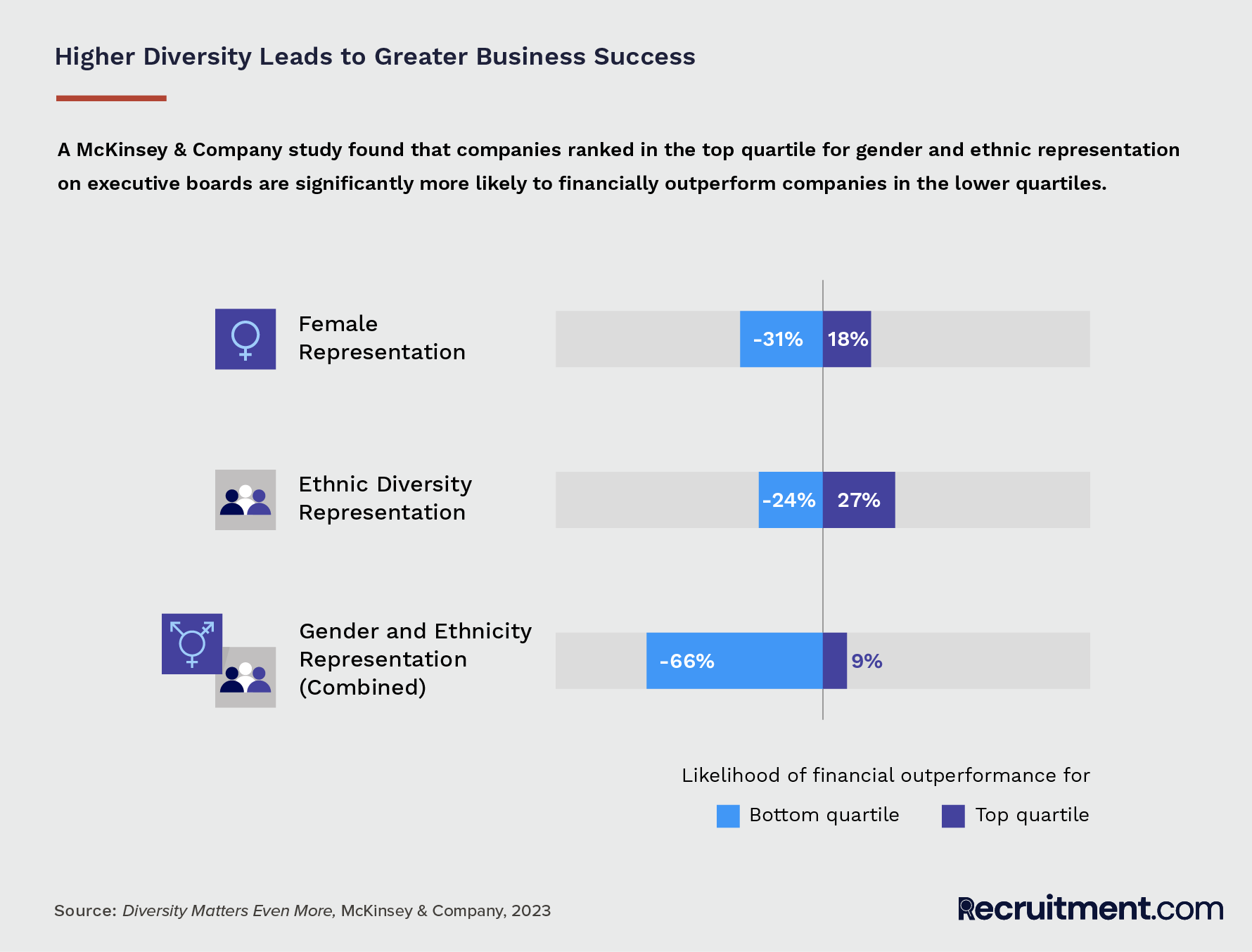5 Ways Recruiters Can Level Up Inclusive Hiring Practices

Phil Fernandes is a recruiter with nearly 10 years of experience at companies like TikTok, PepsiCo, Microsoft, and NSC Global—positions that have taken him all over the world. He is currently a Senior Talent Acquisition Lead at H-E-B.
Recruiter Phil Fernandes shares actionable approaches to enrich talent pipelines and drive inclusive hiring practices for a thriving workforce.
Workforce diversity is not about ticking a box or looking good on quarterly reports. Among other benefits, diversity and inclusion hiring is an essential strategy to make your business more money. Once your organization is aligned around this reality, the rest will fall into place.
But if your talent pipeline is lacking diverse candidates, you need to consider a new approach.
Why Is Diversity Important?
All hiring managers want the best of the best when it comes to their new hire—somebody who will come in and hit the ground running with little training and supervision. But rushing through the process is a mistake.

Our job as recruiters is to fine-tune every search to include as much diversity as we can get into the pipeline. This allows us to bring valuable new ideas and fresh perspectives to the team. And it’s not just the right thing to do—it’s also smart business: Companies in the top quartile for gender diversity are 39% more likely to outperform companies in the bottom quartile, according to a McKinsey & Company study.
Here are five strategies—institutional, creative, and everything in between—that have helped me grow my talent pipelines and drive more inclusive recruitment for companies like TikTok and PepsiCo.
1. Leverage Transferable Skills
In building a diverse workforce, it’s crucial to recognize transferable skills and challenge traditional job descriptions. At PepsiCo, when hiring for a health and safety role, I encountered a narrow candidate pool due to overly specific requirements that applicants must have worked in the industry. However, by acknowledging that similar roles exist across various industries, we broadened our search and found candidates with relevant skills and instincts. This approach, though initially met with caution, was embraced by hiring managers once they saw the diverse talent it brought in.
Similarly, while working on a trust and safety role for TikTok in Mexico City, the team sought candidates with specific tech company experience, which was scarce in the local talent pool. However, many people in the area had worked at call centers. By understanding the core responsibilities of the trust and safety role and identifying transferable skills from the locals’ call center experience (e.g., troubleshooting and working with performance indicators), we were able to expand the candidate pool and bring in more diverse perspectives.
Rethinking job descriptions is essential for inclusivity, while challenging narrow criteria like specific degrees also avoids excluding qualified candidates—particularly women—who may hesitate to apply if they don’t meet all the listed requirements. By collaborating with hiring managers to adjust job descriptions based on essential skills rather than strict criteria, we can ensure a more inclusive hiring process is being used, broadening the talent pool and redefining boundaries for a diverse and talented workforce.

2. Expand Your Reach
One of the most useful features on LinkedIn Talent Insights—a paid recruiting product from LinkedIn—is that it will show you the breakdown of female versus male talent in any given area so you can see the actual talent available to you locally. If only 10% of women have the skill set that you’re looking for locally, it’s obviously going to be harder to hire female talent for the role you’re filling. You can also see how your salary range compares to that of other companies recruiting for the same role.
When I see such lopsided ratios, and I want to make sure we have more women in the pipeline, I know that my sourcing strategy needs to directly engage different communities to make that happen. I’ve found a few great groups that I tap into in these situations. There’s one called Women in Manufacturing, which is a platform—specific to the supply chain world—where you can host virtual career fairs and virtual hiring events to target female talent.
Social media can also help drive company awareness in communities on a brand level. One of my struggles with recruiting in Mexico City was that people there didn’t see TikTok as a tech employer—they just thought of it as an app. Because of this, we weren’t getting enough applicants organically. I worked with our branding team to push out messages to potential candidates from call centers explaining what TikTok as a company stood for and what it was actually like to work there. We already had a lot of “day in the life of a TikTok worker” videos created by employees themselves, so I drew up a list of target companies and target profiles. The employer branding team then created ads using the videos and pushed them out to the folks I had targeted. As soon as we ran the ads, we had hundreds of new applicants every day. It was amazing how powerful those targeted ads were and how much industry diversity we were able to bring into our search as a result.
3. Partner With Learning Development Teams
It’s important to build your talent pipeline with the skill set you need in mind. Three resources that can help facilitate this are colleges, internal programs, and nonprofit programs.
College Recruiting
Historically Black colleges and universities (HBCUs) are institutions where you'll find highly motivated, ambitious candidates. On LinkedIn, you can actually filter talent by HBCUs.
One additional way that I find racially diverse talent is to search LinkedIn by sororities or fraternities that I know to be specifically Black organizations, such as: Alpha Kappa Alpha sorority, Delta Sigma Theta sorority, Zeta Phi Beta sorority, Phi Beta Sigma fraternity, Alpha Phi Alpha fraternity, and Kappa Alpha Psi fraternity. Although this isn’t a codified LinkedIn search option yet, sometimes candidates will include Greek affiliations in their profiles, and that can be a great way to identify talented candidates of color.
Internal Programs
Many large companies have created their own successful internal pipelines. At PepsiCo, for instance, our designate program aimed to help hire diverse candidates into leadership roles within the company. An employee who didn’t have a lot of experience could shadow an existing leader in a manufacturing facility for six months and learn by doing.
Nonprofit Programs
When I worked in Cincinnati, Ohio, I discovered an organization called Per Scholas that worked with people under the poverty line, provided them with laptops and access to scholarships, and helped them get ready for interviews. It also offered tuition-free CompTIA A+ training, which is a certification that essentially tells employers that you know how to take a computer apart and put it back together again.
When I was recruiting for help desk support roles, we were struggling to find the right candidates. I initiated a relationship with Per Scholas as a way for us to get a different profile in the door. I would recruit folks who were still in the program or who had just completed it. Even better, graduates of this program have already gone through a background check as a requirement of the course, which means they could be hired quickly and are cleared to work in the US.
If your organization doesn’t already have a relationship with a nonprofit like Per Scholas, it could be beneficial to seek one out and nurture a partnership with it. Most urban areas will have something similar.
4. Help Hiring Managers Eliminate Bias
Training is an important tool to subvert institutional bias, but it’s rarely enough, and it’s often on those in talent acquisition to educate colleagues. When I partner with a hiring manager, instead of calling out the biases I see—which can make them uncomfortable and defensive—I start with a conversation. What skills are you looking for? What systems do you need the candidate to know? What keywords should we be looking for?

The question is really: What else can we do from a recruiting strategy standpoint to find the right talent? The goal is to find the right fit for the company; if you initiate the conversation that way, instead of waving a diversity or bias flag, hiring managers tend to accept widening the pipeline.
5. Showcase Success Stories
My final piece of advice is to go back to your stakeholders and show them how well your creative inclusive recruiting and sourcing methods worked. This will make it easier for you to sell it the next time.
I schedule biweekly calls with the larger team to hear feedback and see how the candidates are doing. Without exception, the hiring managers are thrilled. We hired talent that the team probably would have otherwise passed on, because they would have looked at the résumé gaps and different technical experience and said, “No, this candidate doesn’t have the exact skills we need.” But when they see the level of candidates that are actually coming in, and see how they perform in the roles, they get excited.
Diverse Talent Is the Future
At the end of the day, our job as recruiters is to make a company stronger and more financially successful. And diversity is far more than just hitting metrics or achieving brownie points within your company. It is a tool to help find the top employees for your organization. When you invest—and I mean really invest, using my advice—you’ll be amazed by the results.
So let’s commit to going beyond the status quo and actively seeking out diverse talent. Let’s broaden our networks and champion inclusivity at every stage of the hiring process. By doing so, we not only enrich our teams but also contribute to building stronger, more resilient businesses that thrive in today’s diverse and dynamic world. Together, let’s level up our inclusive hiring practices and pave the way for a brighter, more equitable future.

Phil Fernandes is a recruiter with nearly 10 years of experience at companies like TikTok, PepsiCo, Microsoft, and NSC Global—positions that have taken him all over the world. He is currently a Senior Talent Acquisition Lead at H-E-B.



